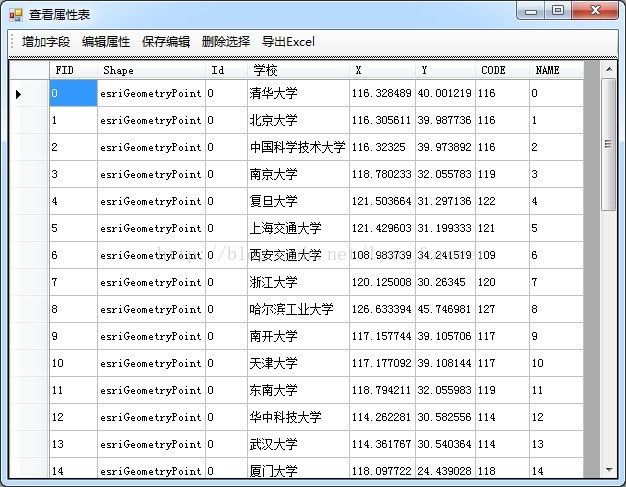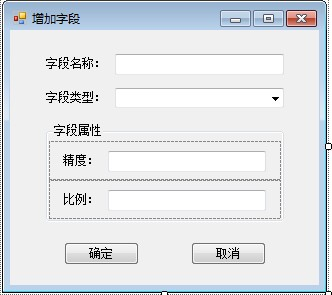实现的操作包括:1、打开属性表;2、编辑属性表;3、增加属性列;4、数据排序;5、字段计算……
嗯,实现的功能目前就这些吧,后续还会继续跟进,还望大家多多关注……下面就分功能说说我的实现方式吧……
1、打开属性表
属性表的打开是在TOC的右键菜单中打开的,首先新建一个类OpenAttribute,继承BaseCommand,OpenAttribute类的源码如下:
using System; using System.Collections.Generic; using System.Linq; using ESRI.ArcGIS.ADF.BaseClasses; using ESRI.ArcGIS.Controls; namespace MapDemo { public sealed class OpenAttribute : BaseCommand { IMapControl3 m_mapControl; AxMapControl _MapControl; public OpenAttribute(AxMapControl pMapControl) { base.m_caption = "查看属性表"; _MapControl = pMapControl; } public override void OnClick() { formTable formtable = new formTable(_MapControl, m_mapControl); formtable.Show(); } public override void OnCreate(object hook) { m_mapControl = (IMapControl3)hook; } } }
解释一下,AxMapControl参数是为了后面属性表操作时刷新视图的。接着在toc右键事件中添加代码:
m_menuLayer.AddItem(new OpenAttribute(mapMain), -1, 2, false, esriCommandStyles.esriCommandStyleIconAndText);

如此这般,这般如此,我们期待的属性表就出现了,效果呢比较丑陋,莫怪莫怪……
属性表打开之后呢,大家就看到了有关属性表操作的一些功能了,不过呢,属性表的大开的工作还尚未完成。接下来呢,添加如下引用:
完了之后,定义一下变量:
- AxMapControl _MapControl;
- IMapControl3 m_mapControl;
- public DataTable dt2;
- ITableSort pTs;//处理排序
- bool up = true;
- int row_index = 0;
- int col_index = 0;
- public string strAddField = "";
- RowAndCol[] pRowAndCol = new RowAndCol[10000];
- int count = 0;
这个窗口的参数为:
public formTable(AxMapControl pMapControl,IMapControl3 pMapCtrl) { InitializeComponent(); _MapControl = pMapControl; m_mapControl = pMapCtrl; }
这样,下面就可以显示属性了,在form_load事件中写如下代码:
TableShow();
此处,调用了TableShow方法,TableShow的代码如下:

public void TableShow() { ILayer pLayer = (ILayer)m_mapControl.CustomProperty; IFeatureLayer pFLayer = pLayer as IFeatureLayer; IFeatureClass pFeatureClass = pFLayer.FeatureClass; if (pFeatureClass == null) return; DataTable dt = new DataTable(); DataColumn dc = null; for (int i = 0; i < pFeatureClass.Fields.FieldCount; i++) { dc = new DataColumn(pFeatureClass.Fields.get_Field(i).Name); dt.Columns.Add(dc); } IFeatureCursor pFeatureCuror = pFeatureClass.Search(null, false); IFeature pFeature = pFeatureCuror.NextFeature(); DataRow dr = null; while (pFeature != null) { dr = dt.NewRow(); for (int j = 0; j < pFeatureClass.Fields.FieldCount; j++) { if (pFeatureClass.FindField(pFeatureClass.ShapeFieldName) == j) { dr[j] = pFeatureClass.ShapeType.ToString(); } else { dr[j] = pFeature.get_Value(j).ToString(); } } dt.Rows.Add(dr); pFeature = pFeatureCuror.NextFeature(); } gdvAttribute.DataSource = dt; dt2 = dt; }
这样呢,属性表的显示就完成了。
2、新增字段
先看看那个“新增字段”按钮的事件吧……
ILayer pLayer = (ILayer)m_mapControl.CustomProperty;
IFeatureLayer pFLayer = pLayer as IFeatureLayer;
formAddField formaddfield = new formAddField(pFLayer, gdvAttribute);
formaddfield.Show();
此处,调用了窗体formAddField ,传递的参数是IFeatureLayer pFLayer 和DataGridView gdvAttribute,那么,下面看看formAddField的设计以及实现

界面呢也是比较简单,看看formAddField 的代码:

using System; using System.Collections.Generic; using System.ComponentModel; using System.Data; using System.Drawing; using System.Linq; using System.Text; using System.Windows.Forms; using ESRI.ArcGIS.Carto; using ESRI.ArcGIS.Geodatabase; using ESRI.ArcGIS.Controls; namespace MapDemo { public partial class formAddField : Form { private IFeatureLayer _FeatureLayer = null; private DataGridView _dgv; public formAddField(IFeatureLayer pFeatureLayer, DataGridView dgv) { InitializeComponent(); _FeatureLayer = pFeatureLayer; _dgv = dgv; } private void formAddField_Load(object sender, EventArgs e) { this.cmbFieldType.Items.Add("长整型"); this.cmbFieldType.Items.Add("短整型"); this.cmbFieldType.Items.Add("浮点型"); this.cmbFieldType.Items.Add("双精度"); this.cmbFieldType.Items.Add("文本型"); this.cmbFieldType.Items.Add("日期型"); this.cmbFieldType.SelectedIndex = 0; } /// <summary> /// 改变事件 /// </summary> /// <param name="sender"></param> /// <param name="e"></param> private void cmbFieldType_SelectedIndexChanged(object sender, EventArgs e) { string strFieldType = cmbFieldType.Text; switch (strFieldType) { case "长整型": { panelPrecision.Visible = true; panelScale.Visible = false; break; } case "短整型": { panelPrecision.Visible = true; panelScale.Visible = false; break; } case "浮点型": { panelPrecision.Visible = true; panelScale.Visible = true; break; } case "双精度": { panelPrecision.Visible = true; panelScale.Visible = true; break; } case "文本型": { panelPrecision.Visible = true; panelScale.Visible = false; lblPrecision.Text = "长度"; break; } default://日期型0 { panelPrecision.Visible = false; panelScale.Visible = false; break; } } } private void btnOK_Click(object sender, EventArgs e) { string strFieldName = txtFieldName.Text; string strFieldType = cmbFieldType.Text; try { IFeatureLayer editAttributeLayer = _FeatureLayer; //Field collection IFieldsEdit pFieldsEdit; //获取FeatureLayer IFeatureLayer pFeatureLayer = editAttributeLayer; //从FeatureLayer获取工作空间 IDataset pDataSet = pFeatureLayer.FeatureClass as IDataset; IWorkspace pWorkSpace = pDataSet.Workspace; //设置字段属性 IField pNewField = new FieldClass(); IFieldEdit pFieldEdit = pNewField as IFieldEdit; pFieldEdit.AliasName_2 = strFieldName; pFieldEdit.Name_2 = strFieldName; switch (strFieldType) { case "长整型": { pFieldEdit.Type_2 = esriFieldType.esriFieldTypeInteger; pFieldEdit.Precision_2 = int.Parse(txtPrecision.Text); break; } case "Class1.cs短整型": { pFieldEdit.Type_2 = esriFieldType.esriFieldTypeSmallInteger; pFieldEdit.Precision_2 = int.Parse(txtPrecision.Text); break; } case "浮点型": { pFieldEdit.Type_2 = esriFieldType.esriFieldTypeSingle; pFieldEdit.Precision_2 = int.Parse(txtPrecision.Text); pFieldEdit.Scale_2 = int.Parse(txtScale.Text); break; } case "双精度": { pFieldEdit.Type_2 = esriFieldType.esriFieldTypeDouble; pFieldEdit.Precision_2 = int.Parse(txtPrecision.Text); pFieldEdit.Scale_2 = int.Parse(txtScale.Text); break; } case "文本型": { pFieldEdit.Type_2 = esriFieldType.esriFieldTypeString; pFieldEdit.Length_2 = int.Parse(txtPrecision.Text); break; } default://日期型0 { pFieldEdit.Type_2 = esriFieldType.esriFieldTypeDate; break; } } //添加字段 try { int theField = pFeatureLayer.FeatureClass.Fields.FindField(strFieldName); if (theField == -1) { pFeatureLayer.FeatureClass.AddField(pFieldEdit); MessageBox.Show("字段添加成功!"); } else { MessageBox.Show("字段已经存在!"); } } catch (Exception ex) { MessageBox.Show("Field " + pFieldEdit.Name + " was not added due to an error (" + ex.Message + " )"); } } catch (System.Exception ex) { MessageBox.Show(ex.Message); } this.Close(); RefreshTable refresh = new RefreshTable(); refresh.Refresh(_dgv, _FeatureLayer); } private void btnCancle_Click(object sender, EventArgs e) { this.Close(); } } }
首先,在窗体加载的时候将数据类型添加进去,之后在类型选择改变时触发其属性控制控件的显示或者改变,接下来就是最重要的添加字段了,大家注意到了,在this.Close()之后,还调用了RefreshTable 的Refresh方法,传递的参数是datagridview _dgv和Ifeaturelayer _FeatureLayer,Refresh方法主要是实现添加自断后显示的刷新,由于后面还有涉及到,所以,这个后面一并说。
3、编辑属性并保存
还是先看看那两个按钮的时间吧:

private void toolEditor_Click(object sender, EventArgs e) { gdvAttribute.ReadOnly = false; this.gdvAttribute.CurrentCell = this.gdvAttribute.Rows[this.gdvAttribute.Rows.Count - 2].Cells[0]; } /// <summary> /// 保存编辑 /// </summary> /// <param name="sender"></param> /// <param name="e"></param> private void toolSave_Click(object sender, EventArgs e) { gdvAttribute.ReadOnly = true; ILayer pLayer = (ILayer)m_mapControl.CustomProperty; IFeatureLayer pFLayer = pLayer as IFeatureLayer; IFeatureClass pFeatureClass = pFLayer.FeatureClass; ITable pTable; //pTable = pFeatureClass.CreateFeature().Table;//很重要的一种获取shp表格的一种方式 pTable = pFLayer as ITable; //将改变的记录值传给shp中的表 int i = 0; while (pRowAndCol[i].Column != 0 || pRowAndCol[i].Row != 0) { IRow pRow; pRow = pTable.GetRow(pRowAndCol[i].Row); pRow.set_Value(pRowAndCol[i].Column, pRowAndCol[i].Value); pRow.Store(); i++; } count = 0; for (int j = 0; j < i; j++) { pRowAndCol[j].Row = 0; pRowAndCol[j].Column = 0; pRowAndCol[j].Value = null; } MessageBox.Show("保存成功!", "提示", MessageBoxButtons.OK); }
在保存属性表的时候,出现了pRowAndCol,对他的定义如下:

public struct RowAndCol { //字段 private int row; private int column; private string _value; //行属性 public int Row { get { return row; } set { row = value; } } //列属性 public int Column { get { return column; } set { column = value; } } //值属性 public string Value { get { return _value; } set { _value = value; } } }
4、删除选择
顾名思义,就是删除选择的行,这里的选择可以是多选,也可是单选,看看对应按钮的事件吧:
private void toolDelSelect_Click(object sender, EventArgs e) { if (((MessageBox.Show("确定要删除吗", "警告", MessageBoxButtons.YesNo)) == DialogResult.Yes)) { ILayer pLayer = (ILayer)m_mapControl.CustomProperty; IFeatureLayer pFLayer = pLayer as IFeatureLayer; ITable pTable = pFLayer as ITable; IRow pRow = pTable.GetRow(row_index); pRow.Delete(); TableShow(); MessageBox.Show("删除成功!", "提示", MessageBoxButtons.OK); _MapControl.ActiveView.Refresh(); } }
此处,看看下面这个事件:
private void gdvAttribute_CellValueChanged(object sender, DataGridViewCellEventArgs e) { //记录值一旦改变触发此事件 //在dataGridView中获取改变记录的行数,列数和记录值 pRowAndCol[count].Row = gdvAttribute.CurrentCell.RowIndex; pRowAndCol[count].Column = gdvAttribute.CurrentCell.ColumnIndex; pRowAndCol[count].Value = gdvAttribute.Rows[gdvAttribute.CurrentCell.RowIndex].Cells[gdvAttribute.CurrentCell.ColumnIndex].Value.ToString(); count++; }
5、导出Excel
首先得添加程序对Microsoft.Office.Interop.Excel的引用,添加完成之后方可导出:

private void toolExpXLS_Click(object sender, EventArgs e) { ILayer pLayer = (ILayer)m_mapControl.CustomProperty; IFeatureLayer pFLayer = pLayer as IFeatureLayer; IFeatureClass pFeatureClass = pFLayer.FeatureClass; IFields pFields = pFeatureClass.Fields; ExportExcel(gdvAttribute, pFields); } private void ExportExcel(DataGridView myDGV, IFields pFields) { string saveFileName = ""; SaveFileDialog saveDialog = new SaveFileDialog(); saveDialog.DefaultExt = "xls"; saveDialog.Filter = "Excel文件|*.xls"; saveDialog.ShowDialog(); saveFileName = saveDialog.FileName; if (saveFileName.IndexOf(":") < 0) return; //被点了取消 Microsoft.Office.Interop.Excel.Application xlApp = new Microsoft.Office.Interop.Excel.Application(); if (xlApp == null) { MessageBox.Show("无法创建Excel对象,可能您的机子未安装Excel"); return; } Microsoft.Office.Interop.Excel.Workbooks workbooks = xlApp.Workbooks; Microsoft.Office.Interop.Excel.Workbook workbook = workbooks.Add(Microsoft.Office.Interop.Excel.XlWBATemplate.xlWBATWorksheet); Microsoft.Office.Interop.Excel.Worksheet worksheet = (Microsoft.Office.Interop.Excel.Worksheet)workbook.Worksheets[1];//取得sheet1 //写入标题 for (int i = 0; i < myDGV.ColumnCount; i++) { worksheet.Columns.Cells[1, i + 1] = myDGV.Columns[i].HeaderText; } //写入数值 for (int r = 0; r < myDGV.Rows.Count; r++) { for (int i = 0; i < myDGV.ColumnCount; i++) { worksheet.Cells[r + 2, i + 1] = myDGV.Rows[r].Cells[i].Value; } System.Windows.Forms.Application.DoEvents(); } worksheet.Columns.EntireColumn.AutoFit();//列宽自适应 if (saveFileName != "") { try { workbook.Saved = true; workbook.SaveCopyAs(saveFileName); } catch (Exception ex) { MessageBox.Show("导出文件时出错,文件可能正被打开! " + ex.Message); } xlApp.Quit(); GC.Collect();//强行销毁 MessageBox.Show("资料保存成功", "提示", MessageBoxButtons.OK); } }


